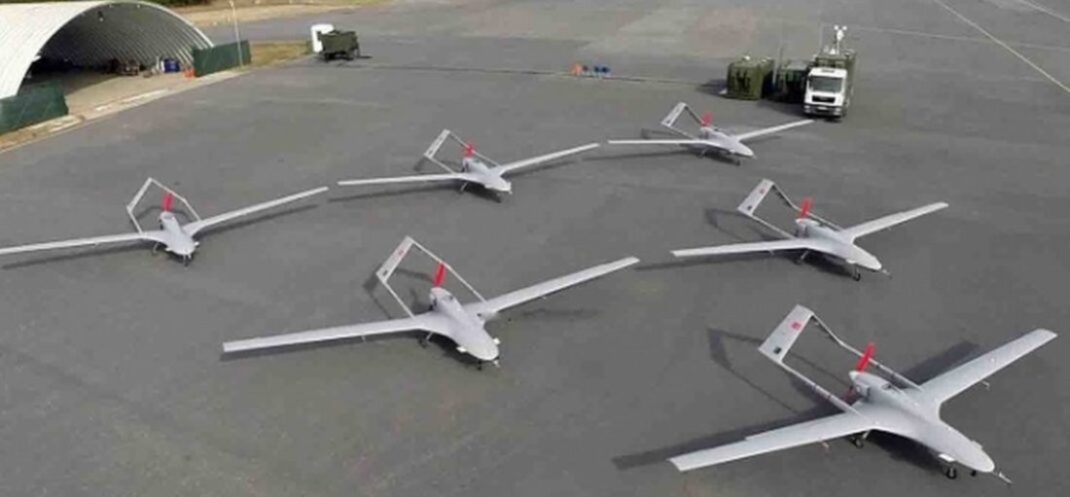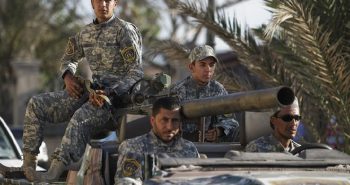By Jason Pack & Wolfgang Pusztai

 The War for Tripoli, launched by Gen. Khalifa Hifter in April 2019, came to an abrupt end in June 2020 after extensive Turkish military capabilities were introduced to the theater at the beginning of the year.
The War for Tripoli, launched by Gen. Khalifa Hifter in April 2019, came to an abrupt end in June 2020 after extensive Turkish military capabilities were introduced to the theater at the beginning of the year.
This research paper seeks to drill down into the military, logistical, and technological aspects of the war, highlighting the unique role of drones, soft-kill and hard-kill air defense technologies, private military contractors, and extraterritorial military professionals in determining its final outcome.
PART (III)
Neither the UAE nor Egypt had demonstrated the will to deliver the comprehensive support of a major regional power. Both countries possessed relatively more advanced military hardware than Turkey, although they lacked the advantages that the Turkish forces have acquired via frequently interfacing with their NATO allies.
Overall, the Egyptians and Emiratis possessed the ability to swing the battle in favor of the LNA, if they were willing to fully commit their joint financial and professional military resources. Yet, they decided not to strike the newly arrived Turkish air defense systems, although they would have certainly been capable of doing so.
Conversely, Wagner Group did not have this capability and — as developments in late May demonstrated (when Russia sent fighter jets to Libya, but did not intervene in the fighting as it did not want to be caught acting too directly in Libya) — neither Wagner nor the Russian air force had the “green light” from the Kremlin to overtly bring their full capacities to bear.
The reasons for this willpower gap between the Turks and the Egyptians, Emiratis, and Russians are further analyzed in the Conclusion.
Mercenaries
From about May 2019, the VoR hired a significant number of mercenaries, some from Chad and some Darfuri rebels, of which the largest single group came from the Justice and Equality Movement.
Conversely, the LNA employed Sudanese Rapid Support Forces (or Janjaweed) and other troops to defend oil installations, Libyan Toubou and Chadian fighters in the south to defend fields and airstrips, and Russian PMCs for more technical jobs.
A smaller number of Assad regime Syrian troops were also brought in on the LNA side, although they likely did not fight in the vicinity of Tripoli.
Conversely, Turkey had started to deploy anti-Assad mercenaries from Syria as ground troops as early as December 2019, just after the signing of the interlocking maritime and military agreements with the GNA the month before.
Most of these fighters belonged to the “Syrian National Army” formed to confront the Assad regime. The majority came from two formations: the Sultan Murad Brigade (consisting partially of Turkmen from the Aleppo area and self-branded as an “Islamist” group) and the al-Sham Brigade (mostly from Idlib and designated as a terrorist organization by the U.S.).
Several others were from the al-Mu’tasim Brigade (Aleppo) and Jabhat al-Nusra (a part of al-Qaeda). For the most part, these groups were well-trained and experienced in cooperating with Turkish combat support.
The VoR’s intention was that these Syrian mercenaries not directly engage in larger offensive operations, but rather be used to provide the infantry manpower necessary to hold and retake terrain when supported via significant artillery and air cover.
This method of utilizing of Syrian mercenaries allowed for certain kinetic offensive operations to be undertaken by Libyan militia personnel, while keeping the body count for pro-GNA fighters of Libyan nationality artificially low.
Until mid-January, only about 1,000 Syrians were deployed, but those figures rose quickly and reached 10,000-12,000 in April/early May, some of them potentially battle-hardened jihadists that Turkey wanted to exfiltrate out of Syria and Turkey.
After this new stage of fighting commenced, about 500 Syrians mercenaries were killed and more than 2,000 wounded by June 2020, with most of those casualties occurring in the Syrians’ first months in Tripoli.
After the initial operations, the mercenaries did not see large-scale infantry battles, but were more involved in holding defensive lines, mopping-up operations, and other low glamor operations where discipline and reliability were essential (two characteristics that Libyan militia fighters have not traditionally displayed).
The relations between some of the Tripoli militias and the Syrians became strained, initially due to Libyan cultural prejudices toward Levantines, and later as a result of instances of harassment of civilians by Syrian mercenaries that were later amplified and possibly exaggerated on social media.
Despite the important functions undertaken by the Syrian mercenaries, they did not truly tip the scales of the battle, just as the LNA’s motley crew of mercenaries had not in the first nine months of the conflict.
Rather, the decisive element in the Turkish campaign plan was the successful neutralization of the LNA’s air force, which had been an essential backbone of Hifter’s battle plan and his initial advantage over GNA forces. From mid-January onwards, a layered GNA air defense system was built up, including several components around the American HAWK XXI SAM system.
Additionally, Turkish-manufactured Korkut 35-mm self-propelled anti-aircraft guns (SPAAG) provided low-level all-weather air defense within 4 km.
Another important component was American Stinger MANPADS operated by Turkish special forces, while modernized ex-U.S., now Turkish, missile frigates of the Gabya class established an early warning and long-range air defense system.
This was a sufficiently effective multipronged anti-aircraft (and anti-drone) system cobbled together from different components at speed. It was also the first of its kind —operated in the middle of a civil war by an extraterritorial military to defeat the opposing side’s third-party patron.
While all this build up was happening, after Jan. 12 the LNA’s air force did not choose to return to the skies of Tripoli in force, as its vintage jets, helicopters, and slower drones would now have been fairly easy prey for the relatively sophisticated and multilayered Turkish air defense system.
Further away from Tripoli, as 2020 went on, there were a few LNA combat drone and attack helicopter sorties in the areas of Sabratha and Abu Grein. These also ended after some of them were shot down by the Turkish frigates and (probably) by Stinger teams.
Therefore, after having reversed which side held air supremacy, the next phase of the Turkish battle plan was an asymmetrical war of attrition to degrade the LNA’s ground forces by using a version of the LNA’s cat-and-mouse air and artillery barrage tactics against them. A precondition for this approach was precise information about the location of Hifter’s troops, artillery, air defense systems, logistics hubs, and headquarters.
Turkish ISR, including signals intelligence (SIGINT) — intercepting and locating signals from communications and other electronic devices on the battlefield — reconnaissance drones, and satellites, provided the necessary information to pinpoint the targets for subsequent destruction by artillery and combat drones.
Before January, the ISR support provided by Turkey/Qatar and Egypt/UAE was at about the same level. Now, the full weight of Turkish capabilities once again changed the situation entirely.
Artillery, Drones, and Radar
Turkey deployed at least one, later probably two batteries of self-propelled 155-mm heavy artillery T-155 Fırtına with extended-range precision-guided ammunition and T-122 Sakarya rocket launchers.
Supported by weapon-locating radar, their first mission was to suppress and destroy the capabilities of the LNA artillery.
Such weapon-locating radar is designed to detect and track incoming mortars, artillery, and rocket fire so as to pinpoint their origin and respond with counter-battery fire within about 30-60 seconds. The LNA was caught off-guard by these rapid shifts in battle dynamics.
After suffering some heavy losses, the LNA brought back a couple of old 2S1 122-mm and 2S3 152-mm self-propelled gun howitzers from Gadhafi-era army stocks, probably with some help from Wagner Group repair and maintenance experts.
Batteries equipped with these guns were initially capable of moving into position, firing a quick salvo of about five or six shells, and leaving before the impact of counter fire. While this worked for some time in the early spring of 2020, combat drones finally hunted down and disabled most of these LNA guns.
Aerial supremacy remained the predominant factor in determining the outcome of most military operations in the Libyan theater. Turkish unmanned combat aerial vehicles (UCAVs, “combat drones”) played a key role over the battlefield.
The Bayraktar TB2 is a 630-kg drone with a weapons payload of just 55 kg (i.e. very light missiles and bombs). It is controlled by a ground control station via line-of-sight datalink.
Limited in its range to 150 km, the TB2s were complemented by TAI Anka-S, which is operated via SATCOM and hence has a broader range capable of covering the whole of Libya and delivering a 200-kg payload.
The Anka-S was mainly used to hunt LNA logistic convoys emanating from Sebha or Jufra, in the Fezzanese or central desert areas respectively, and destined for the Tripoli environs.
Already in 2019, mini-UAVs were used by both sides for battlefield reconnaissance and artillery fire observation. But most of them were commercial models, which proved unreliable and relatively easy to jam. From January 2020 onward, Turkey delivered an increasing number of military models to VoR.
These proved widely resistant to Emirati-Russian-Chinese military and commercial jamming methods, hence allowing the more sophisticated Turkish drone jammers to operate freely and counter the LNA’s mini-UAVs.
This dynamic of increased Turkish jamming of LNA mini-UAVs contributed significantly to the superior situational awareness of VoR and more efficient artillery fire, while slowly diminishing the LNA’s capacities.
The Turning of the Tide
Altogether several dozen TB2 and a few Anka-S were delivered to Libya, presumably operated exclusively by Turkish specialists.
At first, some were shot down by UAE-delivered Russian-made Pantsir S-1 self-propelled SAM/AAA systems, but over time, Turkey managed to counter this threat successfully by relying on the now asymmetrical jamming capabilities.
KORAL long-range electronic warfare systems (EWS) located the radar of the Pantsirs and either jammed them to allow subsequent attack by combat drones or preemptively pinpointed the Pantsirs to enable their destruction with precision long-range artillery at a distance of almost 50 km.
Of all the above-listed developments the defeat of the Pantsirs was among the most significant. In May 2020, the Pantsir operators (some of them Wagner Group personnel) switched their tactics by using their systems mostly in the passive electro-optical mode, which made jamming by KORAL or detection and destruction by artillery less likely.
As a result, several Turkish combat drones were shot down thereafter, but it was already too late to have a real impact on the battlefield dynamics. The remaining Pantsirs were either knocked out of action, captured, or rendered irrelevant by the advancing VoR ground forces.
After the neutralization of the LNA’s air force and then the subsequent destruction of its ability to effectively use anti-aircraft batteries, the Turkish-GNA-VoR war of attrition tactics established the preconditions for the final phase of the battle plan, the breaking of the siege of southern Tripoli and expelling of the surviving Hifter troops from Tripolitania.
Syrians were neither involved in the lightning advance along the coast toward Tunisia to capture Sabratha and Surman (formerly LNA ground bases) in April, nor the occupation of (formerly LNA-controlled) al-Wattiya air base in May, nor in the battle for Tarhuna in June (the stronghold of the LNA’s most important western Libyan allies). Taken together, these actions ended the War for Tripoli.
Sabratha, Surman, al-Wattiya, and Tarhuna had all fallen without major casualties. With air superiority achieved and the LNA defenders open to continual artillery or aerial barrages, they simply fled, continuing a pattern that has characterized Libyan warfare since 2011.
***
Jason Pack is a consultant, author, and commentator with over two decades of experience living in, and working on, the Middle East. In 2008, he moved to Tripoli to assist Western businesses in reentering Libya amidst the late Qadhafi-era reforms. In 2011, Jason created Libya-Analysis LLC — a consultancy organization producing evidence-based analysis, forecasting, business intelligence, and commercial research on Libya. In 2015, Jason founded Eye on ISIS in Libya — a non-profit 501c3 monitoring service detailing the group’s history, its interactions with other jihadi actors, and Western actions toward the group. Currently, he is working on a popular book exploring what Libya’s dysfunctional economic structures and its ongoing civil war tells us more broadly about globalization and the geopolitics of the 21st century.
Wolfgang Pusztai, Austria’s former defense attaché to Libya (2007-12), is a security and policy analyst with a special focus on the MENA region. He is the chairman of the advisory board of the “National Council on U.S.-Libya Relations,” .
_________





